Relationship between Green Space and Mortality in the Cities of the Yangtze River Delta Urban Agglomeration
Abstract
1. Introduction
2. Materials and Methods
2.1. Study Region
2.2. Data Collection
2.2.1. Landscape Attributes of GS
2.2.2. All-Cause Mortality and Socioeconomic Conditions
2.2.3. Statistical Analysis
3. Results
3.1. Spatial Pattern of All-Cause Mortality
3.2. Spatial Variation of GS in the YRDUA
3.3. Socioeconomic Conditions of the Cities in the YRDUA
3.4. Effects of GS Attributes and Socioeconomic Conditions
4. Discussion
4.1. Spatial Pattern of Mortality in the YRDUA
4.2. Personal Wealth Is Strongly Correlated with Mortality
4.3. Landscape Configuration of GS Affected Mortality
4.4. Study Limitations
5. Conclusions
Supplementary Materials
Author Contributions
Funding
Data Availability Statement
Acknowledgments
Conflicts of Interest
References
- United Nations. World Population Prospects 2022, 1 July 2022. Available online: https://population.un.org/wpp (accessed on 15 March 2024).
- Lu, Z.N.; Chen, H.Y.; Hao, Y.; Wang, J.Y.; Song, X.J.; Mok, T.M. The dynamic relationship between environmental pollution, economic development and public health: Evidence from China. J. Clean. Prod. 2017, 166, 134–147. [Google Scholar] [CrossRef]
- Zhao, X.Y.; Wang, W.J.; Wan, W.Y. Regional differences in the health status of Chinese residents: 2003–2013. J. Geogr. Sci. 2018, 28, 741–758. [Google Scholar] [CrossRef]
- Zhang, Y.B.; Li, Y.; Geng, T.T.; Pan, X.F.; Zhou, Y.F.; Liu, G.; Pan, A. Overall lifestyles and socioeconomic inequity in mortality and life expectancy in China: The China health and nutrition survey. Age Ageing 2022, 51, afac167. [Google Scholar] [CrossRef] [PubMed]
- Nieuwenhuijsen, M.J.; Khreis, H.; Verlinghieri, E.; Mueller, N.; Rojas-Rueda, D. Participatory quantitative health impact assessment of urban and transport planning in cities: A review and research needs. Environ. Int. 2017, 103, 61–72. [Google Scholar] [CrossRef] [PubMed]
- Kondo, M.C.; Fluehr, J.M.; McKeon, T.; Branas, C.C. Urban green space and its impact on human health. Int. J. Environ. Res. Public Health 2018, 15, 445. [Google Scholar] [CrossRef] [PubMed]
- Sandifer, P.A.; Sutton-Grier, A.E.; Ward, B.P. Exploring connections among nature, biodiversity, ecosystem services, and human health and well-being: Opportunities to enhance health and biodiversity conservation. Ecosyst. Serv. 2015, 12, 1–15. [Google Scholar] [CrossRef]
- Azmy, M.M.; Hosaka, T.; Numata, S. Responses of four hornet species to levels of urban greenness in Nagoya city, Japan: Implications for ecosystem disservices of urban green spaces. Urban. For. Urban. Green. 2016, 18, 117–125. [Google Scholar] [CrossRef]
- Lõhmus, M.; Balbus, J. Making green infrastructure healthier infrastructure. Infect. Ecol. Epidemiol. 2015, 5, 30082. [Google Scholar] [CrossRef] [PubMed]
- Rojas-Rueda, D.; Nieuwenhuijsen, M.J.; Gascon, M.; Perez-Leon, D.; Mudu, P. Green spaces and mortality: A systematic review and meta-analysis of cohort studies. Lancet Planet. Health 2019, 3, e469–e477. [Google Scholar] [CrossRef]
- Wolch, J.R.; Byrne, J.; Newell, J.P. Urban green space, public health and environmental justice: The challenge of making cities “just green enough”. Landsc. Urban. Plan. 2014, 125, 234–244. [Google Scholar] [CrossRef]
- Felici, A.; Peduzzi, G.; Giorgolo, F.; Spinelli, A.; Calderisi, M.; Monreale, A.; Farinella, R.; Pellungrini, R.; Canzian, F.; Campa, D. The local environment and germline genetic variation predict cancer risk in the UK Biobank prospective cohort. Environ. Res. 2024, 241, 117562. [Google Scholar] [CrossRef] [PubMed]
- Aerts, R.; Stas, M.; Vanlessen, N.; Hendrickx, M.; Bruffaerts, N.; Hoebeke, L.; Dendoncker, N.; Dujardin, S.; Saenen, N.D.; Van Nieuwenhuyse, A.; et al. Residential green space and seasonal distress in a cohort of tree pollen allergy patients. Int. J. Hyg. Environ. Health 2020, 223, 71–79. [Google Scholar] [CrossRef]
- Markevych, I.; Schoierer, J.; Hartig, T.; Chudnovsky, A.; Hystad, P.; Dzhambov, A.M.; de Vries, S.; Triguero-Mas, M.; Brauer, M.; Nieuwenhuijsen, M.J.; et al. Exploring pathways linking greenspace to health: Theoretical and methodological guidance. Environ. Res. 2017, 158, 301–317. [Google Scholar] [CrossRef] [PubMed]
- Chen, R.; Cui, X.; Lei, Y. Coordination analysis of urban forest and urban development level: A case study of the Yangtze River Delta urban agglomeration, China. Sustainability 2023, 15, 15165. [Google Scholar] [CrossRef]
- National Health Commission of PRC. China Health Statistics Yearbook; Peking Union Medical College Press: Beijing, China, 2021. [Google Scholar]
- Ng, E.; Chen, L.; Wang, Y.; Yuan, C. A study on the cooling effects of greening in a high-density city: An experience from Hong Kong. Build. Environ. 2012, 47, 256–271. [Google Scholar] [CrossRef]
- Yuan, C.; Shan, R.; Zhang, Y.; Li, X.-X.; Yin, T.; Hang, J.; Norford, L. Multilayer urban canopy modelling and mapping for traffic pollutant dispersion at high density urban areas. Sci. Total Environ. 2019, 647, 255–267. [Google Scholar] [CrossRef] [PubMed]
- Astell-Burt, T.; Feng, X. Does sleep grow on trees? A longitudinal study to investigate potential prevention of insufficient sleep with different types of urban green space. SSM Popul. Health 2020, 10, 100497. [Google Scholar] [CrossRef]
- Harris, V.; Kendal, D.; Hahs, A.K.; Threlfall, C.G. Green space context and vegetation complexity shape people’s preferences for urban public parks and residential gardens. Landsc. Res. 2018, 43, 150–162. [Google Scholar] [CrossRef]
- Holtan, M.T.; Dieterlen, S.L.; Sullivan, W.C. Social life under cover: Tree canopy and social capital in Baltimore, Maryland. Environ. Behav. 2015, 47, 502–525. [Google Scholar] [CrossRef]
- Yang, J.; Huang, X. The 30 m annual land cover dataset and its dynamics in China from 1990 to 2019. Earth Syst. Sci. Data 2021, 13, 3907–3925. [Google Scholar] [CrossRef]
- Friedman, J.; Hastie, T.; Tibshirani, R. Regularization paths for generalized linear models via coordinate descent. J. Stat. Softw. 2010, 33, 1–22. [Google Scholar] [CrossRef] [PubMed]
- Tay, J.K.; Narasimhan, B.; Hastie, T. Elastic net regularization paths for all generalized linear models. J. Stat. Softw. 2023, 106, 1–31. [Google Scholar] [CrossRef] [PubMed]
- Legendre, P.; Legendre, L. Numerical Ecology; 3rd English edition; Elsevier Science BV.: Amsterdam, The Netherlands, 2012. [Google Scholar]
- Crouse, D.L.; Pinault, L.; Balram, A.; Hystad, P.; Peters, P.A.; Chen, H.; von Donkelaar, A.; Martin, R.V.; Ménard, R.; Robinchaud, A.; et al. Urban greenness and mortality in Canada’s largest cities: A national cohort study. Lancet Planet. Health 2017, 1, e289–e297. [Google Scholar] [CrossRef] [PubMed]
- James, P.; Hart, J.E.; Banay, R.F.; Laden, F. Exposure to greenness and mortality in a nationwide prospective cohort study of women. Environ. Health Perspect. 2016, 124, 1344–1352. [Google Scholar] [CrossRef] [PubMed]
- Nieuwenhuijsen, M.J.; Gascon, M.; Martinez, D.; Ponjoan, A.; Blanch, J.; Garcia-Gil, M.D.M.; Ramos, R.; Foraster, M.; Mueller, N.; Espinosa, A.; et al. Air pollution, noise, blue space, and green space and premature mortality in Barcelona: A mega cohort. Int. J. Environ. Res. Public Health 2018, 15, 2405. [Google Scholar] [CrossRef] [PubMed]
- Zijlema, W.L.; Stasinska, A.; Blake, D.; Dirgawati, M.; Flicker, L.; Yeap, B.B.; Golledge, J.; Hankey, G.J.; Nieuwenhujisen, M.; Heyworth, J. The longitudinal association between natural outdoor environments and mortality in 9218 older men from Perth, Western Australia. Environ. Int. 2019, 125, 430–436. [Google Scholar] [CrossRef] [PubMed]
- Orioli, R.; Antonucci, C.; Scortichini, M.; Cerza, F.; Marando, F.; Ancona, C.; Manes, F.; Davoli, M.; Michelozzi, P.; Forastiere, F.; et al. Exposure to residential greenness as a predictor of cause-specific mortality and stroke incidence in the Rome longitudinal study. Environ. Health Perspect. 2019, 127, 27002. [Google Scholar] [CrossRef] [PubMed]
- Estruch, R.; Ros, E.; Salas-Salvadó, J.; Covas, M.I.; Corella, D.; Arós, F.; Gómez-Gracia, E.; Ruiz-Gutiérrez, V.; Fiol, M.; Lapetra, J.; et al. Primary prevention of cardiovascular disease with a Mediterranean diet supplemented with extra-virgin olive oil or nuts. N. Engl. J. Med. 2018, 378, e34. [Google Scholar] [CrossRef] [PubMed]
- Livesley, S.J.; McPherson, G.M.; Calfapietra, C. The urban forest and ecosystem services: Impacts on urban water, heat, and pollution cycles at the tree, street, and city scale. J. Environ. Qual. 2016, 45, 119–124. [Google Scholar] [CrossRef]
- Zhu, Y.; Wang, Y.; Shrikant, B.; Tse, L.A.; Zhao, Y.; Liu, Z.; Wang, C.; Xiang, Q.; Rangarajan, S.; Li, S.; et al. Socioeconomic disparity in mortality and the burden of cardiovascular disease: Analysis of the Prospective Urban Rural Epidemiology (PURE)-China cohort study. Lancet Public Health 2023, 8, e968–e977. [Google Scholar] [CrossRef]
- Li, C.C.; Du, Z.C.; Fan, S.J.; Mute Browning, M.H.E.; Knibbs, L.D.; Bloom, M.S.; Zhao, T.Y.; Jalaludin, B.; Heinrich, J.; Liu, X.X.; et al. Association between long-term green space exposure and mortality in China: A difference-in-differences analysis of national data in 2000, 2010 and 2019. Sci. Total Environ. 2023, 887, 164023. [Google Scholar] [CrossRef] [PubMed]
- Wang, F.; Liu, S.; Chen, T.; Zhang, H.; Zhang, Y.; Bai, X. How urbanization affects residents’ health risks: Evidence from China. Environ. Sci. Pollut. Res. Int. 2023, 30, 35554–35571. [Google Scholar] [CrossRef]
- Wang, F.; Wei, X.; Liu, J.; He, L.; Gao, M. Impact of high-speed rail on population mobility and urbanisation: A case study on Yangtze River Delta urban agglomeration, China. Transp. Res. A 2019, 127, 99–114. [Google Scholar] [CrossRef]
- Twohig-Bennett, C.; Jones, A. The health benefits of the great outdoors: A systematic review and meta-analysis of greenspace exposure and health outcomes. Environ. Res. 2018, 166, 628–637. [Google Scholar] [CrossRef] [PubMed]
- Gascon, M.; Triguero-Mas, M.; Martínez, D.; Dadvand, P.; Rojas-Rueda, D.; Plasència, A.; Nieuwenhuijsen, M.J. Residential green spaces and mortality: A systematic review. Environ. Int. 2016, 86, 60–67. [Google Scholar] [CrossRef]
- Mitchell, M.G.; Suárez-Castro, A.F.; Martínez-Harms, M.J.; Maron, M.; McAlpine, C.A.; Gaston, K.J.; Johansen, K.L.; Rhodes, J.R. Reframing landscape fragmentation’s effects on ecosystem services. Trends Ecol. Evol. 2015, 30, 190–198. [Google Scholar] [CrossRef] [PubMed]
- Yeh, C.T.; Cheng, Y.Y.; Liu, T.Y. Spatial characteristics of urban green spaces and human health: An exploratory analysis of canonical correlation. Int. J. Environ. Res. Public Health 2020, 17, 3227. [Google Scholar] [CrossRef] [PubMed]
- Wang, H.; Tassinary, L.G. Association between greenspace morphology and prevalence of non-communicable diseases mediated by air pollution and physical activity. Landsc. Urban. Plan. 2024, 242, 10493. [Google Scholar] [CrossRef]
- Sugawara, H.; Shimizu, S.; Takahashi, H.; Hagiwara, S.; Narita, K.-I.; Mikami, T.; Hirano, T. Thermal influence of a large green space on a hot urban environment. J. Environ. Qual. 2016, 45, 125–133. [Google Scholar] [CrossRef] [PubMed]
- Hu, J.; Wu, J.; Sun, Y.; Zhao, X.; Hu, G. Spatiotemporal influence of urban park landscape features on visitor behavior. Sustainability 2023, 15, 5248. [Google Scholar] [CrossRef]
- Hegetschweiler, K.T.; de Vries, S.; Arnberger, A.; Bell, S.; Brennan, M.; Siter, N.; Olafsson, A.S.; Voigt, A.; Hunziker, M. Linking demand and supply factors in identifying cultural ecosystem services of urban green infrastructures: A review of European studies. Urban. For. Urban. Green. 2017, 21, 48–59. [Google Scholar] [CrossRef]
- Bereziartua, A.; Chen, J.; De Hoogh, K.; Rodopoulou, S.; Andersen, Z.J.; Bellander, T.; Brandt, J.; Fecht, D.; Forastiere, F.; Gulliver, J.; et al. Exposure to surrounding greenness and natural-cause and cause-specific mortality in the ELAPSE pooled cohort. Environ. Int. 2022, 166, 107341. [Google Scholar] [CrossRef] [PubMed]
- Hagedoorn, P.; Helbich, M. Longitudinal effects of physical and social neighbourhood change on suicide mortality: A full population cohort study among movers and non-movers in the Netherlands. Soc. Sci. Med. 2022, 294, 114690. [Google Scholar] [CrossRef]
- Ji, J.S.; Zhu, A.; Shi, X. Interaction between residential greenness and air pollution mortality: Analysis of the Chinese Longitudinal Healthy Longevity Survey. Lancet Planet. Health 2020, 4, e107–e115. [Google Scholar] [CrossRef] [PubMed]
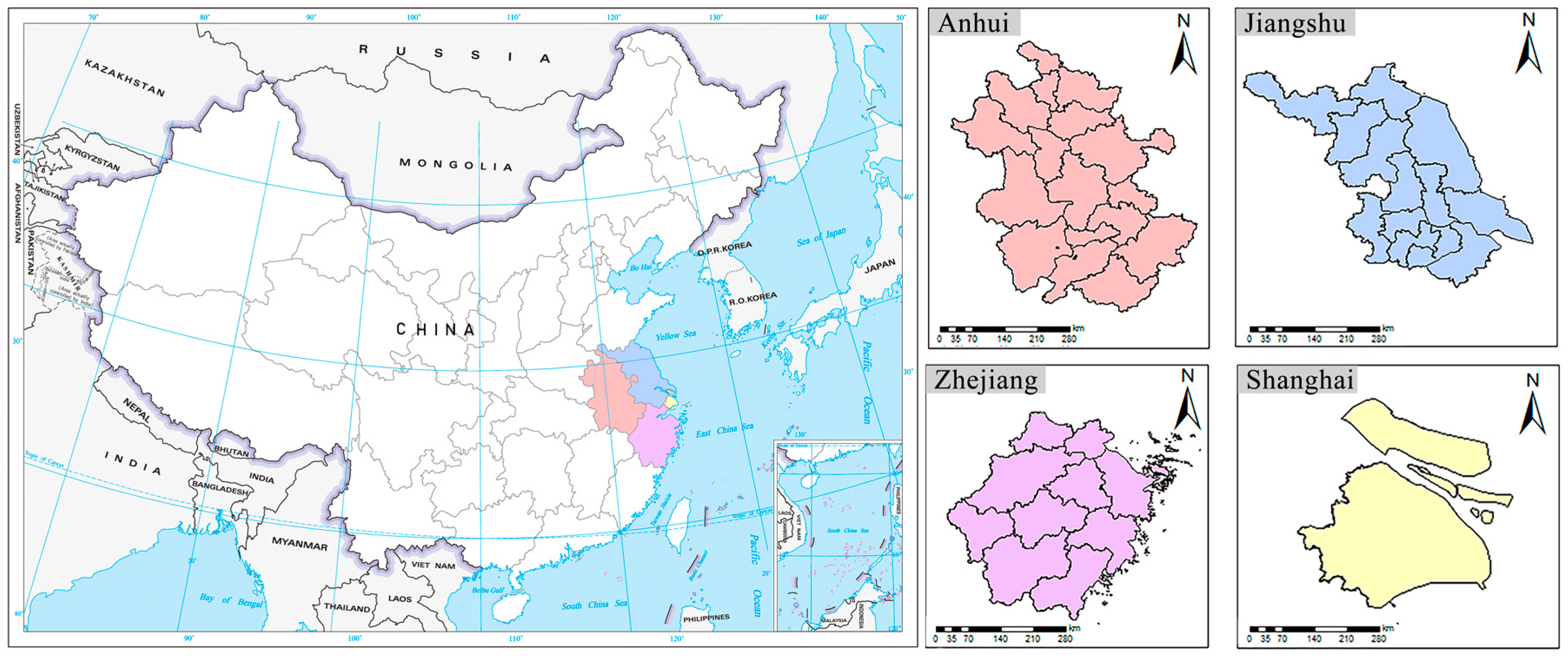
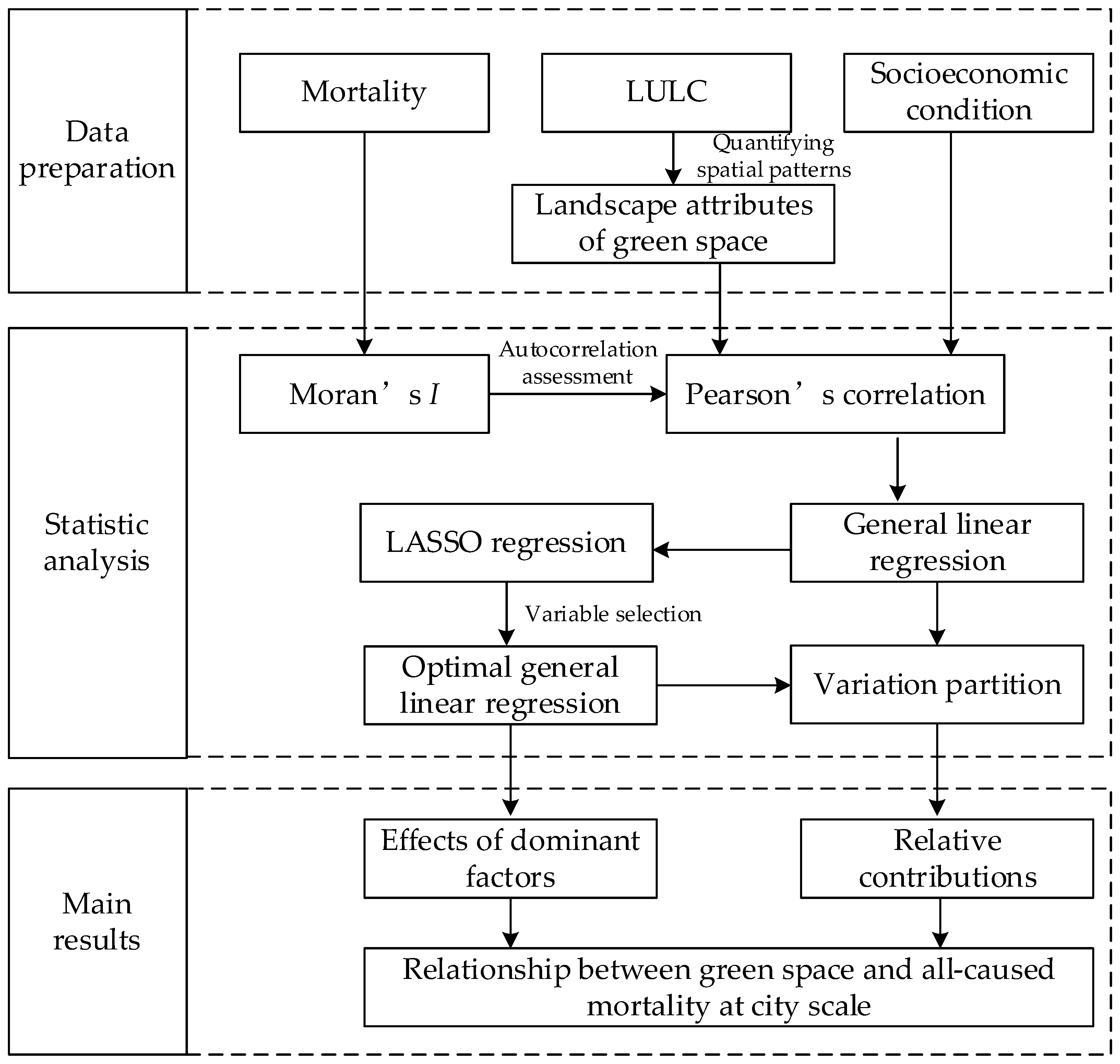
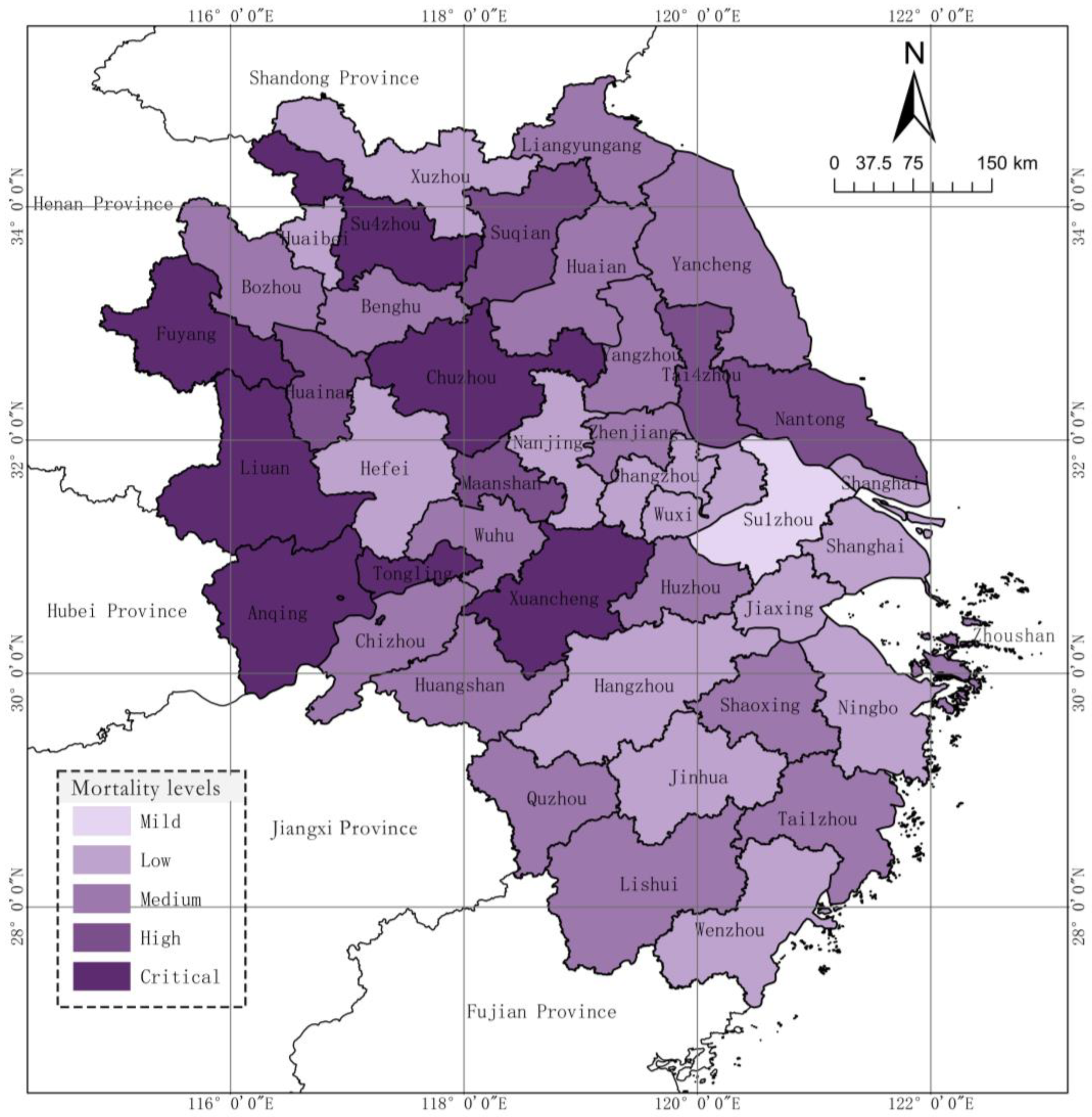
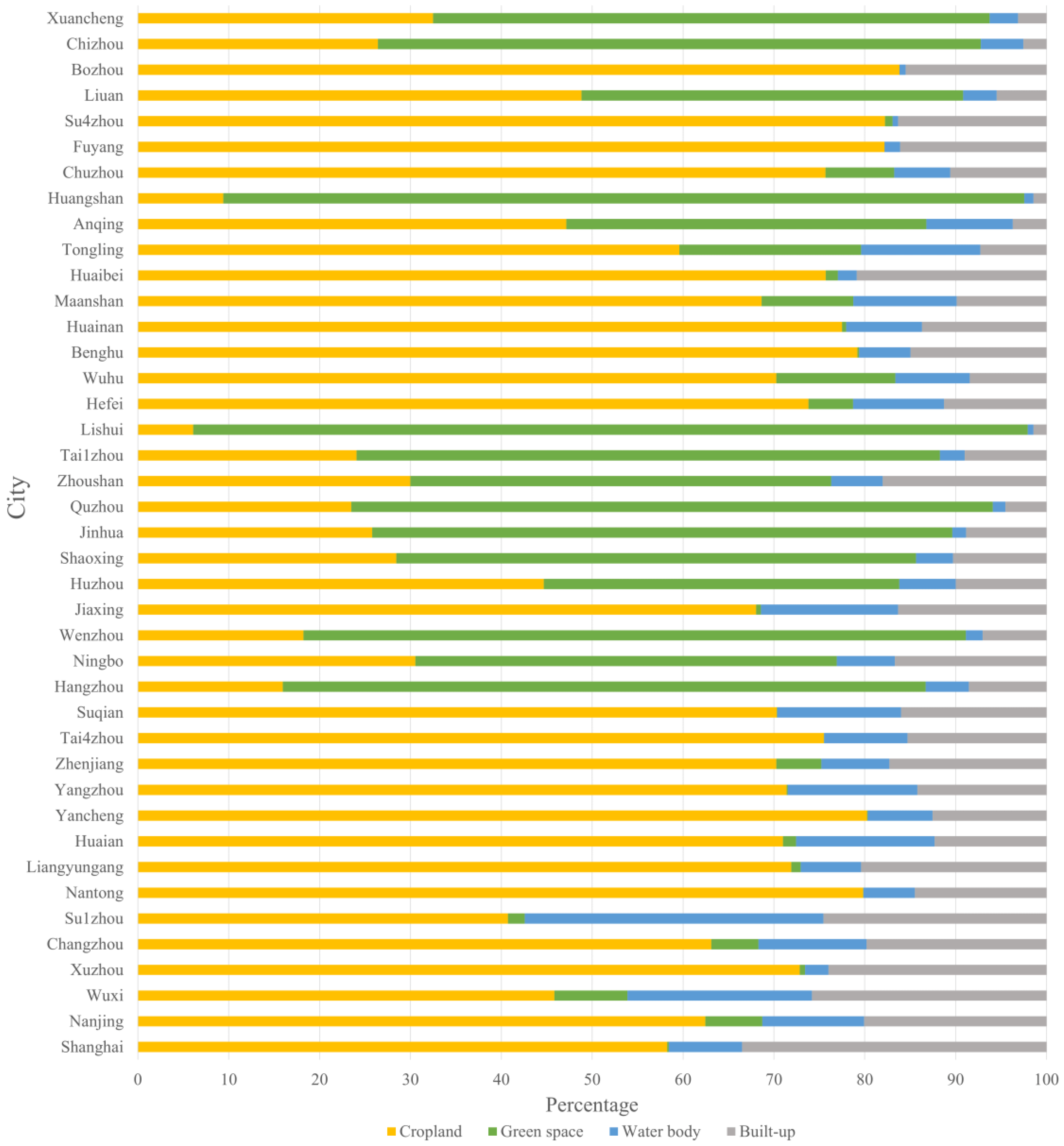
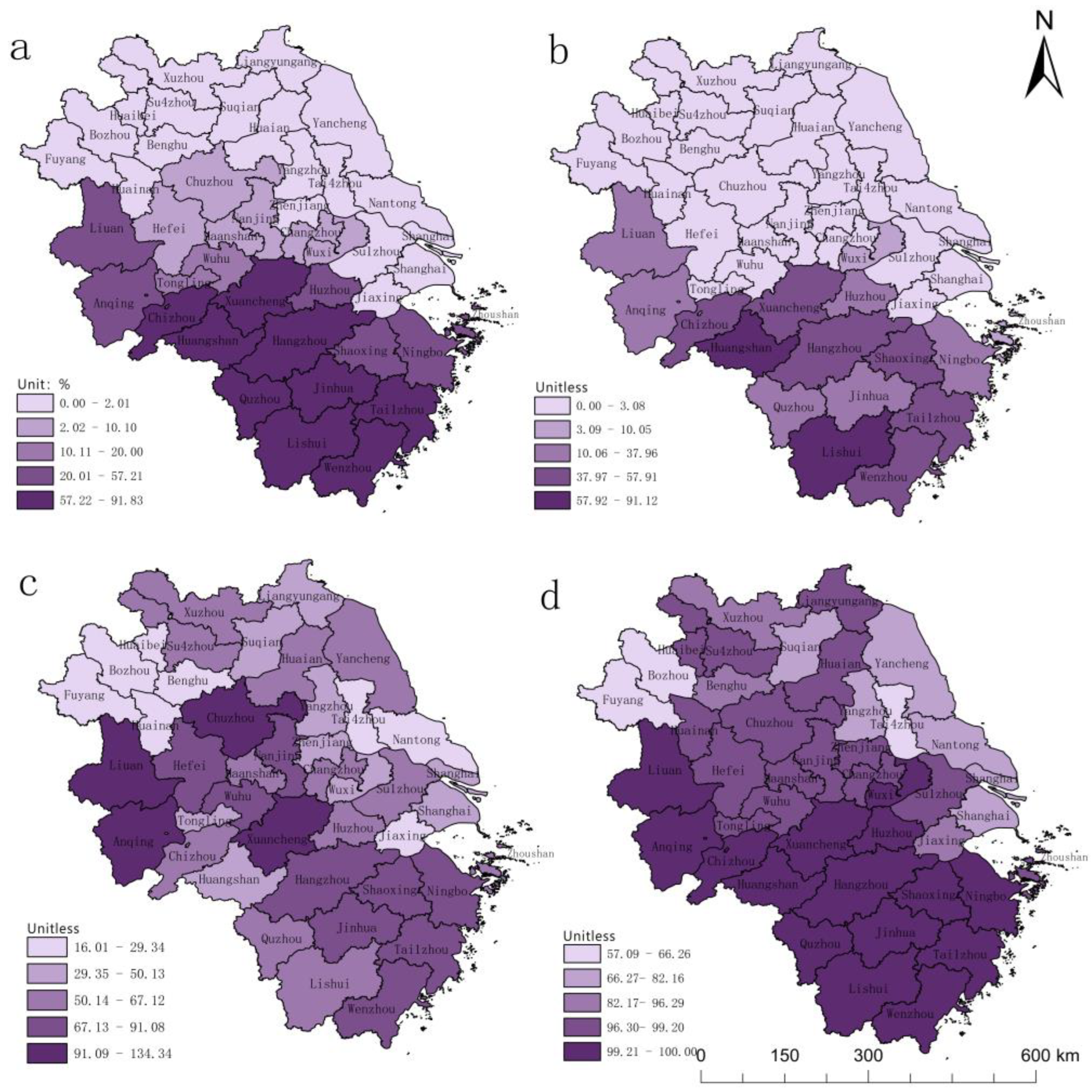
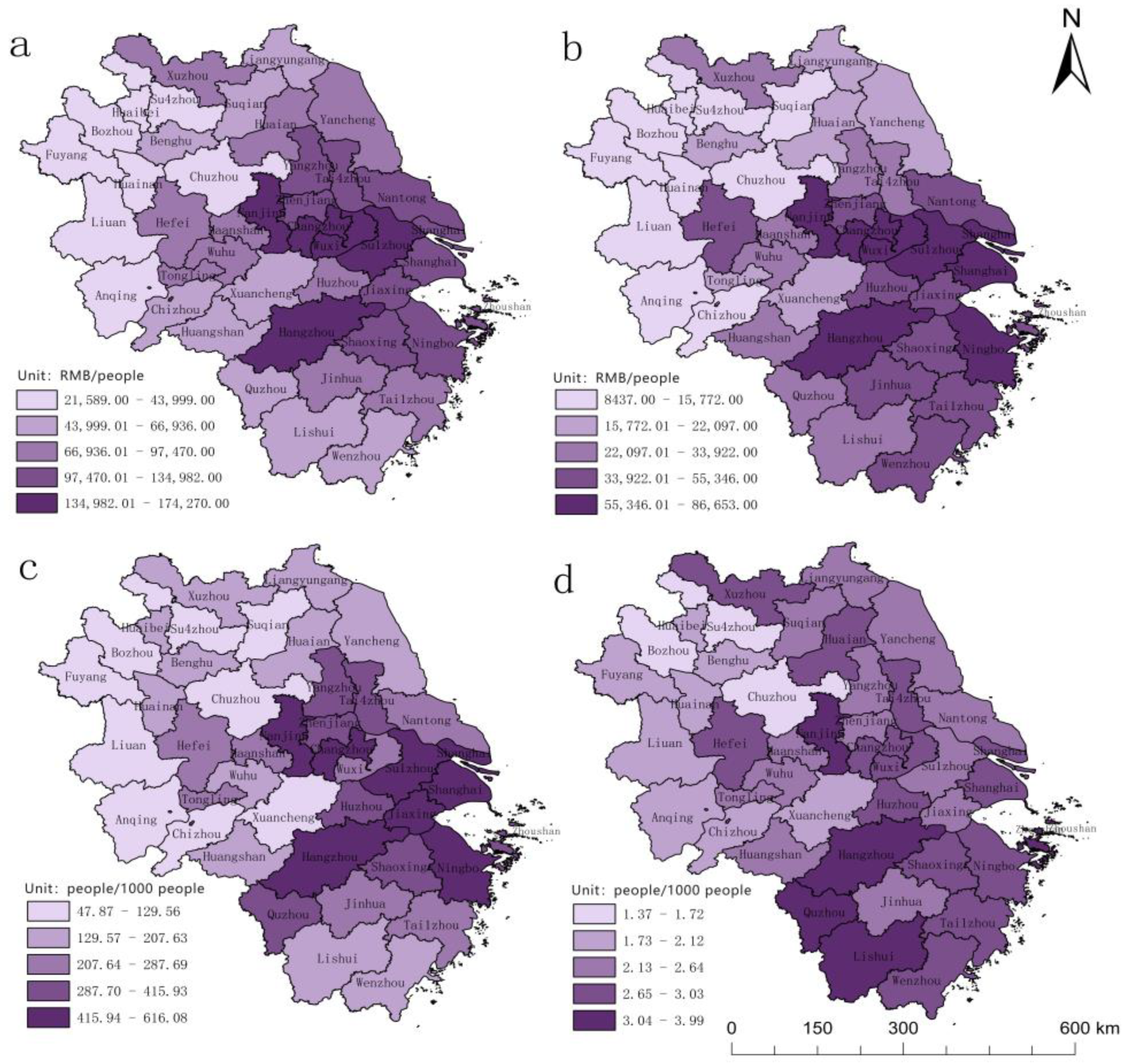
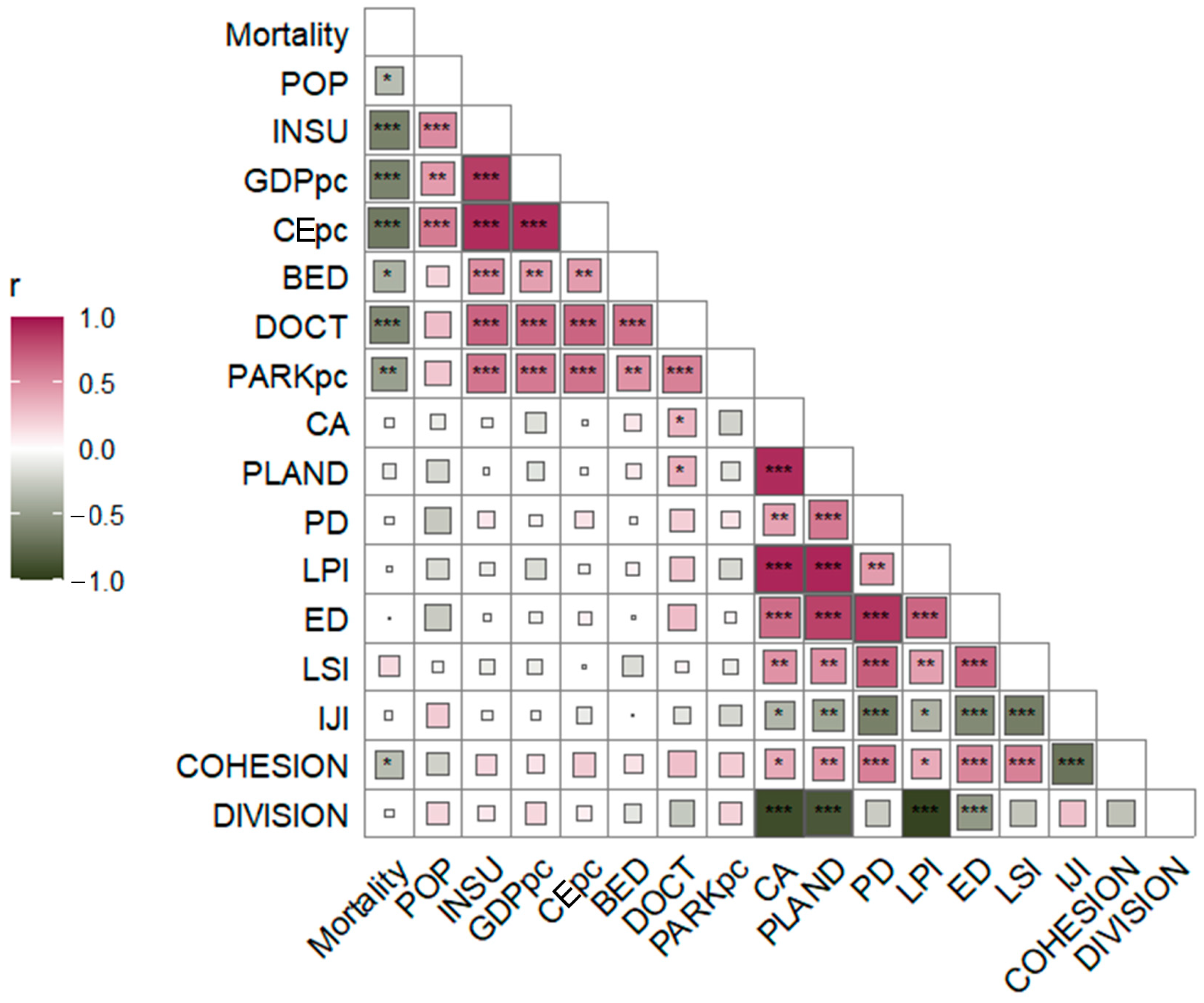
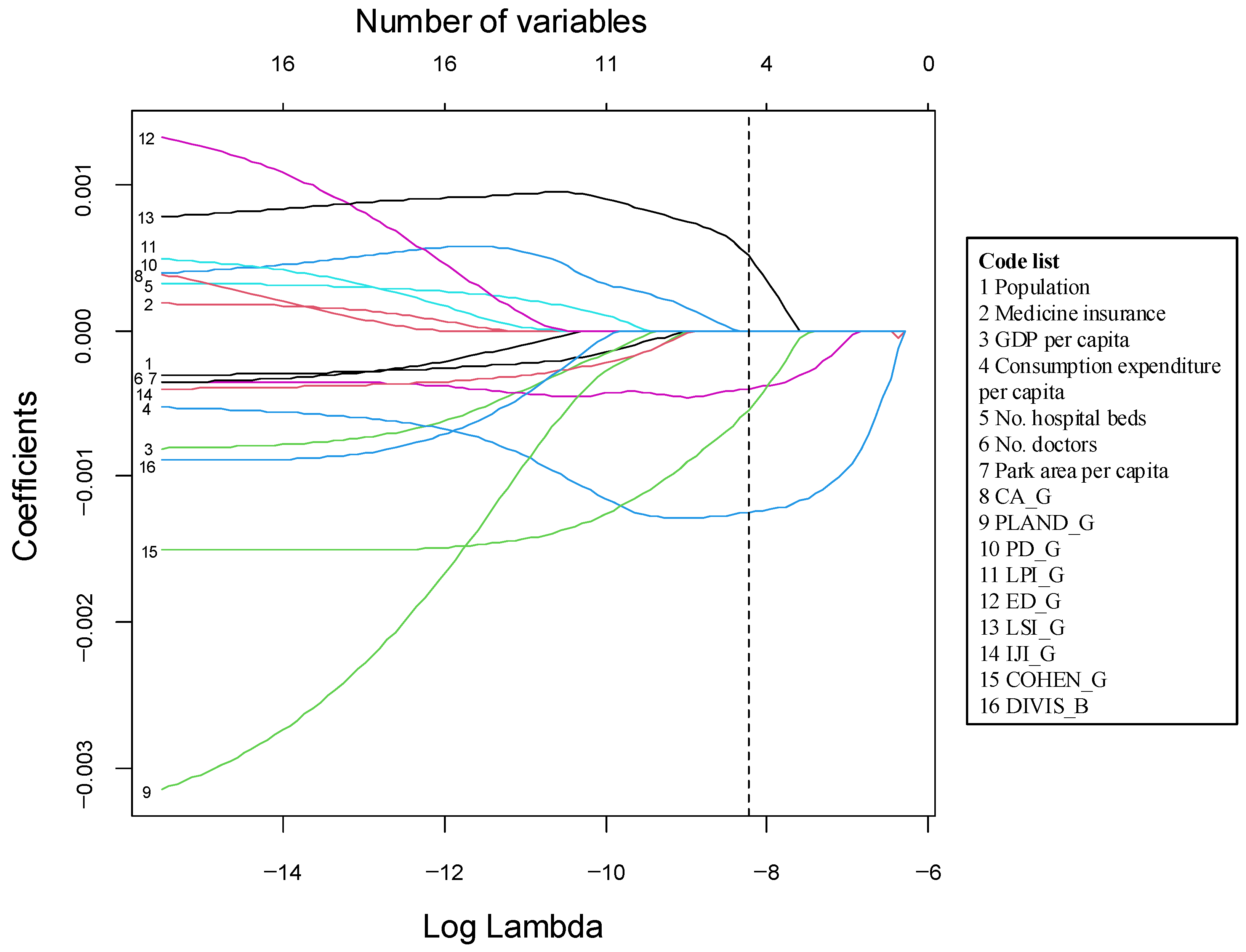
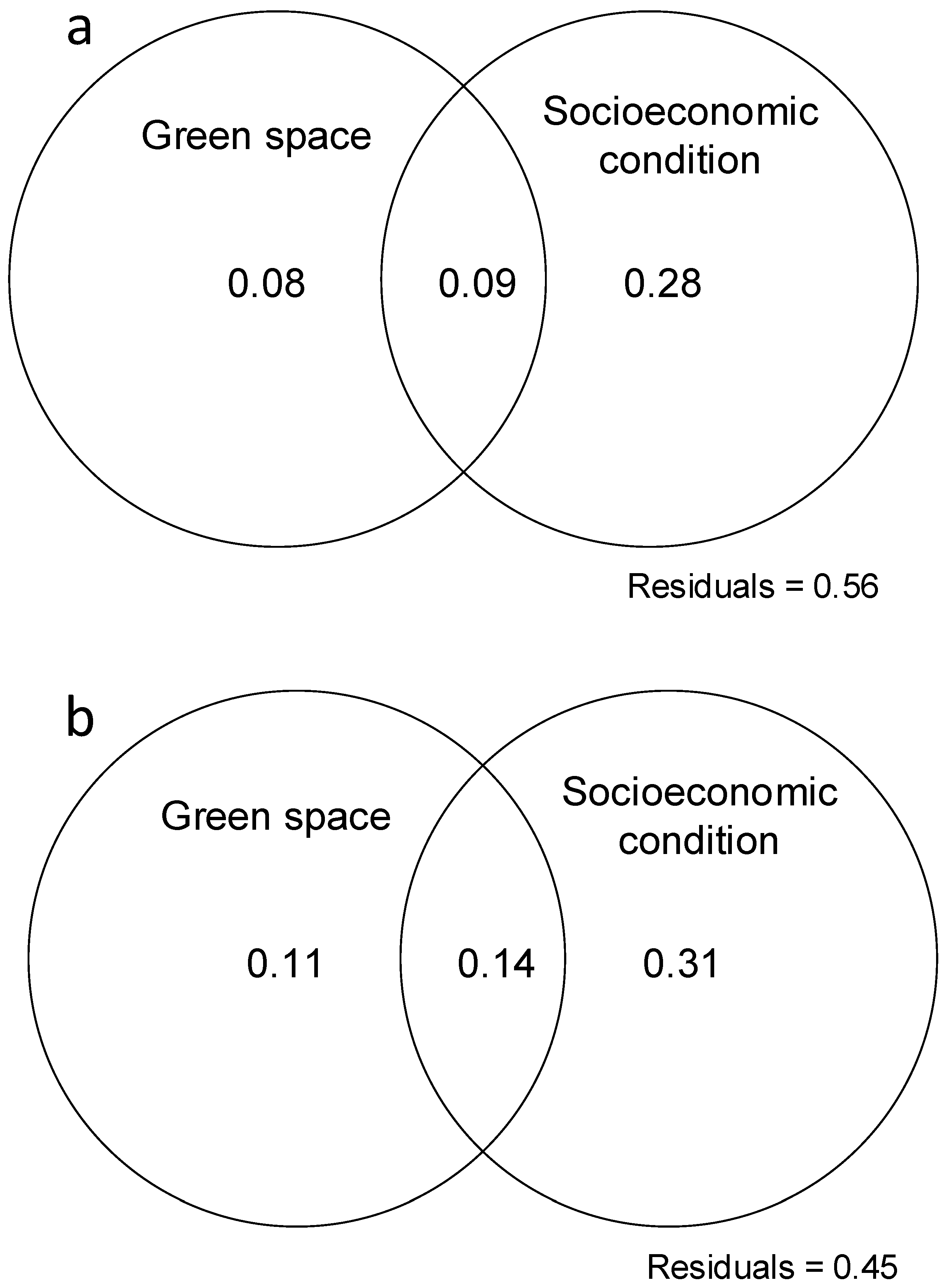
| Code | Landscape Indices | Unit | Description |
|---|---|---|---|
| CA | Total Area | km2 | Total area of green space in the target city |
| PLAND | Percentage of Landscape | % | Proportional abundance of green space in the landscape |
| PD | Patch Density | Item/km2 | Number of green space patches divided by total landscape area |
| LPI | Largest Patch Index | - | Area of the largest patch of green space divided by total landscape area |
| ED | Edge Density | km/km2 | Sum of the lengths of all edge segments of green space, divided by the total landscape area |
| LSI | Landscape Shape Index | - | A standardized measure of total edge or edge density of green space that adjusts for the size of the landscape |
| IJI | Interspersion and Juxtaposition Index | - | A measure of class aggregation like the contagion index, but rather isolates the interspersion or intermixing of green space. |
| COHESION | Patch Cohesion Index | - | A measure of the physical connectedness of green space patches |
| DIVISION | Landscape Division Index | - | The probability that two randomly chosen pixels in the landscape are not situated in the same patch of green space |
| Variables | Code | Description |
|---|---|---|
| Population | POP | Population of each city |
| GDP per capita | GDPpc | Gross Domestic Product per capita of each city |
| Consumption expenditure per capita | CEpc | All expenditures of the resident to meet the daily consumption of households |
| Number of participants in basic medical insurance | INSU | Number of participants in basic medical insurance per 1000 population |
| Number of hospital beds | BED | Number of hospital beds per 1000 population |
| Number of doctors | DOCT | Number of registered doctors per 1000 population |
| Park area per capita | PARKpc | Park area per capita of each city |
| Variables | Estimate | S.E. | t | p-Value |
|---|---|---|---|---|
| CEpc | −5.82 × 10−8 | 1.87 × 10−8 | −3.116 | 0.004 |
| DOCT | −8.92 × 10−4 | 8.06 × 10−4 | −1.107 | 0.276 |
| LSI | 4.14 × 10−5 | 1.36 × 10−5 | 3.051 | 0.004 |
| COHESION | −9.75 × 10−5 | 3.33 × 10−5 | −2.929 | 0.006 |
Disclaimer/Publisher’s Note: The statements, opinions and data contained in all publications are solely those of the individual author(s) and contributor(s) and not of MDPI and/or the editor(s). MDPI and/or the editor(s) disclaim responsibility for any injury to people or property resulting from any ideas, methods, instructions or products referred to in the content. |
© 2024 by the authors. Licensee MDPI, Basel, Switzerland. This article is an open access article distributed under the terms and conditions of the Creative Commons Attribution (CC BY) license (https://creativecommons.org/licenses/by/4.0/).
Share and Cite
Li, M.; Wen, Y.; Hu, G. Relationship between Green Space and Mortality in the Cities of the Yangtze River Delta Urban Agglomeration. Forests 2024, 15, 1066. https://doi.org/10.3390/f15061066
Li M, Wen Y, Hu G. Relationship between Green Space and Mortality in the Cities of the Yangtze River Delta Urban Agglomeration. Forests. 2024; 15(6):1066. https://doi.org/10.3390/f15061066
Chicago/Turabian StyleLi, Mengxue, Yanping Wen, and Guang Hu. 2024. "Relationship between Green Space and Mortality in the Cities of the Yangtze River Delta Urban Agglomeration" Forests 15, no. 6: 1066. https://doi.org/10.3390/f15061066
APA StyleLi, M., Wen, Y., & Hu, G. (2024). Relationship between Green Space and Mortality in the Cities of the Yangtze River Delta Urban Agglomeration. Forests, 15(6), 1066. https://doi.org/10.3390/f15061066






